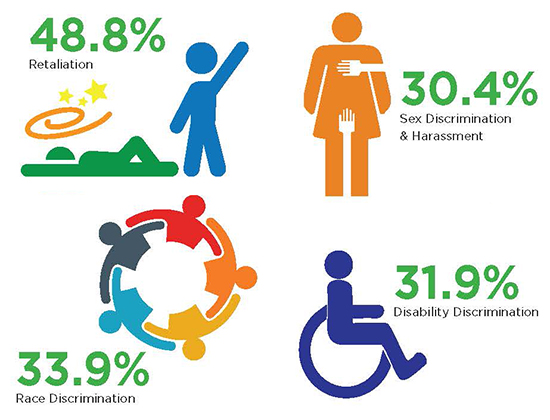
Employers’ concerns about sexual misconduct in the workplace have grown more acute following the recent wave of sexual harassment scandals, and for good reason. The upsurge of workplace sexual harassment allegations triggered by 2017’s #MeToo movement has rippled into 2018, and sexual harassment continues to be in the national spotlight.
What employers might not realize is that the de-stigmatization of speaking out against sexual harassment in the workplace has potentially broader implications. Employees are now more likely to take a harder line against all types of workplace offenses. Victims of sexual harassment and other workplace misconduct have been emboldened to speak up. We are in the midst of a cultural transformation of sorts, and employers must be prepared to manage their organizations accordingly.
In early 2018, the Equal Employment Opportunity Commission released its fiscal year 2017 enforcement and litigation data. Notably, sex discrimination and harassment charges account for only 30.4 percent of all charges filed in 2017, and they were one of several areas experiencing an uptick in charge activity. Retaliation charges accounted for 48.8 percent of all charges filed in 2017, race discrimination charges were 33.9 percent, and disability discrimination charges were 31.9 percent.
These data, coupled with the assertions of the #MeToo movement, suggest that there may be other, more pervasive offenses occurring in the workplace (such as race and disability discrimination) that could readily become the focus of the next wave of de-stigmatization. In planning for 2018 and beyond, employers should take proactive steps to prepare their organizations for the potential wave of discrimination claims and ensure that they are effectively reacting and responding to complaints.
Proactive Steps
Lawyers should advise their employer clients to take the following steps to minimize the opportunities for sexual harassment to occur.
 Julia Arnold, Marquette 2011, is with the Milwaukee office of Littler Mendelson PC. She defends management in administrative charges and employment litigation before the state and federal courts, the EEOC, the Wisconsin Equal Rights Division, and the Madison Equal Opportunities Commission; has handled appeals to the U. S. Court of Appeals for the Seventh Circuit, Wisconsin courts, and the Wisconsin Labor and Industry Review Commission; and provides human resources counseling on policies and procedures, performance management, hiring, and investigations.
Julia Arnold, Marquette 2011, is with the Milwaukee office of Littler Mendelson PC. She defends management in administrative charges and employment litigation before the state and federal courts, the EEOC, the Wisconsin Equal Rights Division, and the Madison Equal Opportunities Commission; has handled appeals to the U. S. Court of Appeals for the Seventh Circuit, Wisconsin courts, and the Wisconsin Labor and Industry Review Commission; and provides human resources counseling on policies and procedures, performance management, hiring, and investigations.
Acknowledge that #MeToo is not a Passing Fad. Accept that the #MeToo movement may require a paradigm shift in the workplace. Because many employees are looking for their employers to recognize and support the movement, companies may consider voicing their support of the movement and the need to fight sexism and other biases inside and outside the workplace. Knowing that this has become a priority for a company’s culture will heighten employees’ awareness of potential misconduct (and its seriousness) and serve to foster respect and professionalism in the workplace. If a company prefers to take a more understated approach, it may consider revamping its employee training as discussed in further detail below.
Set (or Reset) the Tone at the Top. Empower leaders and managers to create a culture that prohibits inappropriate behavior and encourages employees to speak up while feeling safe about reporting concerns. Ensuring that managers understand and emphasize the importance of respectful and professional relationships in the workplace not only helps to prevent misconduct but also can lead to increased morale, productivity, and engagement. Reiterate that managers must lead by example and are the eyes and ears of the company when it comes to appropriately addressing misconduct.
Act Swiftly. If the #MeToo movement has sparked rumblings that an employer might have its very own headline-making actor whose bad behavior (whether related to gender or any other protected class) is known, but has not been formally reported through a complaint, immediately investigate, address, and correct it with the appropriate disciplinary action, training, or both.
webXtra
<iframe src="//www.youtube.com/embed/9AkcQZJxHSM" width="525" height="295" frameborder="0" allowfullscreen></iframe>
Sara Geenen and Erica Reib discuss Sexual Harassment Claims and Misconduct in the #MeToo Era.
Take a Hard Look at Documented Policies. Anti-discrimination and anti-harassment policies are tools for identifying the rules for a company’s workforce and the company’s commitment to following the rules and conveying the company’s culture. Some considerations when reviewing policies include the following:
-
Are policies adequately defined? Do they provide examples of sexual and other unlawful harassment? For example, do they make clear that sexual harassment does not require physical touching but could also include jokes and comments (even if well-intentioned)?
-
Do policies explain that harassment can be perpetrated by anyone, regardless of their gender, race, or other protected category? For example, sex- or race-based harassment can occur between two people of the same sex or race, respectively.
-
Do they address off-duty conduct that violates company policy? For example, do they explain that sexual harassment of another employee outside the office or after hours (for example, on Facebook) still violates company policy and is grounds for disciplinary action?
-
Do they address how the company handles harassment or discrimination by third parties, such as vendors, contractors, or customers?
Review Complaint-reporting Procedures. Are there adequate, multiple reporting channels? If an employee is instructed to report any misconduct to his or her supervisor (who may be the perpetrator), this could create a chilling effect on the employee’s willingness to make a complaint.
Meet Our Contributors
Why do you do what you do? What's the best advice you ever received? Share your weirdest courtroom story...
Lawyers have a lot to say. Our authors are no exception. Whether its personal, insightful, or fun, it’s always interesting.
Check out our Q&A with the author below
Consider Conducting an Audit of Complaints. Auditing complaints received for a given time period can help to determine whether they are appropriately escalated and documented and may reveal vulnerabilities within an organization. For example, how serious were the complaint allegations, were they appropriately documented, did they warrant investigation, and if so, was the complaint investigated? Answers to these questions may suggest that those employees responsible for receiving, analyzing, and escalating complaints need additional guidance or training.
Additionally, complaints filed more frequently at certain locations or among the same teams might suggest that further training or coaching is necessary. Surveying employees in locations with multiple complaints can help to shed light on the nature of the conduct that is the subject of the complaints so that it can be appropriately addressed and mitigated.
Reconsider the Approach to Training. Anti-discrimination and anti-harassment training is typically focused on compliance rather than culture change and often only provides employees with obvious examples of unlawful workplace conduct rather than the subtler conduct that more commonly occurs. As a result, many employees lack the tools necessary to identify and respond to comments or conduct that violates company policy. Because complaints are frequently made to an employee’s direct supervisor, it is crucial that they are appropriately and adequately trained. Hands-on, interactive training, particularly for managers, is often more effective than training videos that employees view at their desks.
2017 Enforcement & Litigation Charges Filed with the EEOC

Reactive Steps
Sometimes prevention is not sufficient. Below are suggestions for responding if a harassment complaint is received in a workplace.
Investigate Complaints Promptly and Thoroughly. If a company receives a complaint of harassment or discrimination of any kind, a manager must promptly conduct a thorough investigation and take measures to ensure that the conduct at issue ceases. Below are some key components to consider when conducting investigations:
-
Time is of the essence. Courts have found that delays of as little as one month between receipt of a complaint and initiation of an investigation meant the response was not sufficiently prompt and warranted an award of punitive damages. Date all notes taken as part of an investigation – whether from an interview or on the final report.
-
Preserve all evidence related to the complaint. This includes everything from emails and text messages to paper documents. If the complaint becomes the subject of litigation, failure to preserve documents could result in monetary penalties or a judge or jury drawing an adverse inference against the company.
-
Planning an investigation is just as important as conducting it. Does the company have investigation guidelines, protocols, or best practices? These tools can be helpful in ensuring that investigations are consistent and thorough.
-
Ensure that the individual assigned to the investigation has the skill set necessary to conduct a thorough and effective investigation. Using untrained investigators can result in poor questioning of witnesses, interviewing the wrong witnesses, and incomplete interview notes and investigative reports. Ineffective or inexperienced investigators are certainly not ideal witnesses when it comes to litigation. If a manager is not confident that the company can handle the investigation internally, he or she should consider engaging a third party to conduct the investigation.
-
When documenting witness interviews, stick to the facts. Do not make credibility determinations. However, it is important to document nonverbal cues suggesting a witness is not credible (for example, Jane was not making eye contact and had her arms crossed during the entire interview).
-
Prepare a final report that identifies the allegations raised and the steps taken during the investigation, including the witnesses interviewed, documents gathered and reviewed, policies and procedures that pertain to the allegations, conclusion drawn, and action taken after the investigation is complete. Investigation-related documents are frequently key exhibits during employment litigation. Investigators must bear in mind that anything they prepare should be easily understood by a third party (for example, judge or juror) who was not involved in the investigation.
Review Previous Complaint Investigations. Because investigations are so significant, employers may consider conducting an audit of complaint investigations to ensure that they were thorough and well documented. For example, were the relevant documents gathered, reviewed, and preserved? Were the appropriate witnesses interviewed, and were they asked the right questions? Were the interviews adequately documented? What was the outcome of the investigation, was it supported by the investigative fact findings, and was it documented?
You May Also Be Interested In …
Identifying and Preventing Workplace Sexual Harassment in the Wake of #MeToo – 2018
From Harvey Weinstein to Matt Lauer, 2017 was a year of explosive sexual harassment scandals impacting people in multiple industries. As harassment accusations continue to dominate the headlines, businesses are under heightened scrutiny to quickly and effectively address workplace misconduct.
This State Bar of Wisconsin PINNACLE® OnDemand seminar is your roadmap to help clients deal with misconduct legally and sensitively.
Conclusion
The #MeToo movement may be the sign of a changing tide, and it is more important than ever that employers work proactively to establish a professional, respectful workplace. Taking a preemptive approach to this cultural transformation not only reduces the legal risk to organizations but also clarifies performance and behavioral expectations, which are vital to maintaining and retaining a strong, productive workforce.
Meet Our Contributors
Your practice focuses on representing employers on employment law matters. What does that entail?
 I counsel and represent employers on a wide variety of employment law matters arising under state and federal law. In addition to advising employers regarding the day-to-day management of employment matters, I defend them in administrative charges and employment litigation before the state and federal courts, the Equal Employment Opportunity Commission, the Wisconsin Equal Rights Division, and the Madison Equal Opportunities Commission. I’ve handled appeals to the U.S. Court of Appeals for the Seventh Circuit, Wisconsin courts, and the Wisconsin Labor and Industry Review Commission. I also conduct workshops and seminars on employment law topics for clients, human resources professionals, and other employment law professionals.
I counsel and represent employers on a wide variety of employment law matters arising under state and federal law. In addition to advising employers regarding the day-to-day management of employment matters, I defend them in administrative charges and employment litigation before the state and federal courts, the Equal Employment Opportunity Commission, the Wisconsin Equal Rights Division, and the Madison Equal Opportunities Commission. I’ve handled appeals to the U.S. Court of Appeals for the Seventh Circuit, Wisconsin courts, and the Wisconsin Labor and Industry Review Commission. I also conduct workshops and seminars on employment law topics for clients, human resources professionals, and other employment law professionals.
Julia Arnold, Littler Mendelson PC, Milwaukee.
Become a contributor! Are you working on an interesting case? Have a practice tip to share? There are several ways to contribute to Wisconsin Lawyer. To discuss a topic idea, contact Managing Editor Karlé Lester at (800) 444-9404, ext. 6127, or email klester@wisbar.org. Check out our writing and submission guidelines.
